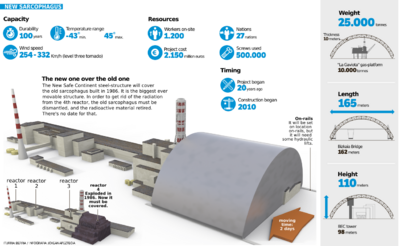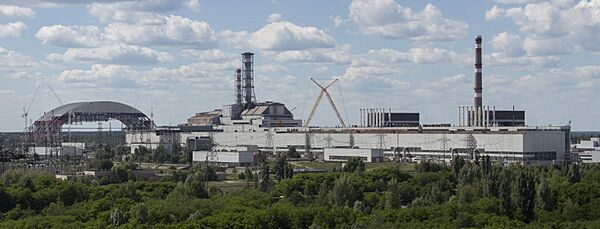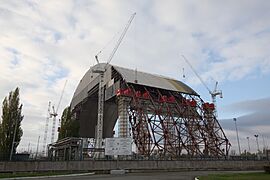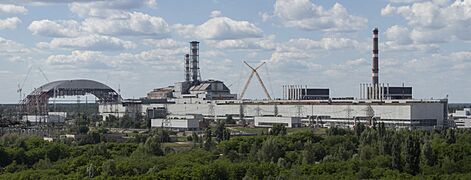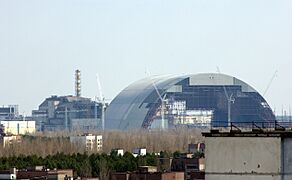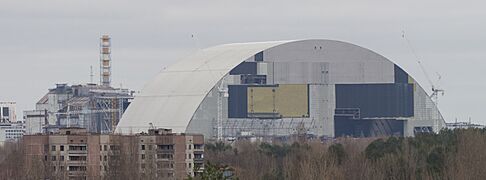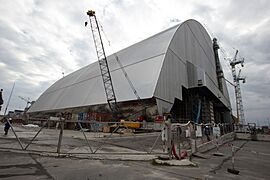Chernobyl New Safe Confinement facts for kids
Quick facts for kids Chernobyl New Safe Confinement |
|
|---|---|
|
Новий чорнобильський саркофаг
|
|
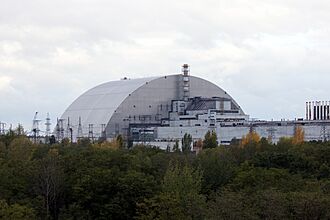
The New Safe Confinement in its final position over the destroyed reactor 4 in October 2017
|
|
| Alternative names | New Shelter |
| General information | |
| Status | Damaged, power supplies cut. |
| Type | Containment structure |
| Location | Chernobyl Nuclear Power Plant |
| Town or city | Pripyat |
| Country | Ukraine |
| Coordinates | 51°23′21″N 30°05′36″E / 51.3893°N 30.0932°E |
| Construction started | September 2010 |
| Completed | November 2016 |
| Cost | €2.1 billion |
| Client | Government of Ukraine |
| Height | 108 metres (354.3 ft) |
| Dimensions | |
| Weight | 31,000 tonnes |
| Other dimensions | Span 260 metres (853.0 ft), external length 165 metres (541.3 ft) |
| Technical details | |
| Structural system | Arch-shaped lattice, clad with sandwich panels |
| Material | Steel, with polycarbonate inner panels |
| Design and construction | |
| Main contractor | Novarka consortium, including Vinci Construction and Bouygues Travaux Publics |
The New Safe Confinement (NSC), also known as the New Shelter, is a massive structure built to cover the destroyed reactor 4 at the Chernobyl Nuclear Power Plant in Ukraine. The reactor was destroyed in the Chernobyl disaster of 1986. The NSC is like a giant, protective shield placed over the old, crumbling shelter that was built right after the accident.
Completed in 2016, the NSC was designed to do several important jobs for at least 100 years:
- Stop any radioactive materials from escaping into the environment.
- Protect the damaged reactor from weather like rain and snow.
- Allow workers to safely take apart the old structures inside using remote-controlled robots.
The NSC is a huge international project. The main goal is to make the site environmentally safe. The word "confinement" is used because its main job is to lock away solid radioactive materials, which is different from the "containment" buildings at normal power plants that hold in gases.
The French group Novarka designed and built the NSC. The total cost of the project was about €1.5 billion.
Contents
The First Shelter, The Sarcophagus
The original shelter, often called the sarcophagus, was built in a hurry between May and November 1986. It was an emergency solution to cover the radioactive materials inside the destroyed reactor 4. Workers built it in very dangerous conditions with high levels of radiation.
The sarcophagus was a success at the time, trapping most of the radioactive material inside. However, it was never meant to be a permanent solution. It was built on the damaged walls of the reactor building, which were not very stable.
Over the years, the sarcophagus began to weaken and deteriorate. There was a risk that it could collapse, which would release radioactive dust. To prevent this, workers did repairs to make it stronger, but a new, long-term solution was needed. This led to the plan to build the New Safe Confinement.
Designing a Giant Shield
Finding the Best Idea
In 1994, the government of Ukraine held a competition, asking experts from around the world for ideas on how to replace the old sarcophagus. There were almost 400 ideas submitted.
One of the most clever ideas came from a British team. They suggested building a huge arch-shaped structure a safe distance away from the reactor. Then, once it was finished, they would slide it over the old sarcophagus on rails. This plan had two big advantages:
- Safety for workers: Building it away from the reactor meant workers would be exposed to much less radiation.
- A better fit: An arch shape could cover the damaged building perfectly.
This "sliding arch" idea was chosen as the best solution. The French consortium Novarka was hired to design and build it. The project brought together workers and experts from over 20 countries.
How the NSC is Built
The New Safe Confinement is an enormous arch made of steel. It is taller than the Statue of Liberty and long enough to cover a football stadium.
- Height: 108 meters (354 feet)
- Width (Span): 260 meters (853 feet)
- Length: 165 meters (541 feet)
The frame is made of strong steel tubes. The outer walls are made of special three-layer panels to protect the structure from the weather. Inside, smooth polycarbonate panels prevent radioactive dust from sticking to the frame.
To stop the steel from rusting, a special ventilation system blows warm, dry air between the inner and outer layers of the walls. This keeps the humidity low and protects the structure for its 100-year lifespan.
Building and Moving a Megastructure
The Assembly Process
Building the NSC was a huge challenge. It was put together in a special assembly area about 180 meters away from the damaged reactor to keep workers safe.
The process worked like this:
- First, the old sarcophagus was strengthened to make sure it wouldn't collapse during construction.
- Next, huge concrete foundations and rails were built for the arch to sit on.
- The arch was built in two halves. Each half was constructed piece by piece and then lifted up by giant jacks.
- Once the first half was complete, it was slid along the rails to make room to build the second half.
- After both halves were joined together, giant remote-controlled cranes and other equipment were installed inside the arch.
- Finally, the entire structure was ready to be moved.
The Big Slide
In November 2016, the NSC began its slow journey into position. It was pushed along special Teflon pads by powerful hydraulic jacks. The whole process took about two weeks.
When it was finished, the New Safe Confinement became the largest land-based movable structure ever built. It was a major engineering achievement that showed what countries can do when they work together.
Work Inside the Confinement
Taking Apart the Old Shelter
Now that the NSC is in place, the next major task is to safely dismantle the old, unstable sarcophagus. This is a very complex and dangerous job that will be done using remote-controlled equipment.
Two huge bridge cranes are suspended from the ceiling of the NSC. These cranes can move all around the inside of the structure. They can be fitted with different tools, like giant claws, drills, and cutting torches.
Workers will operate these cranes from a safe control room. They will carefully take apart the old roof and walls piece by piece. The pieces will then be cleaned to remove radioactive dust and cut into smaller chunks for safe storage.
Storing Radioactive Waste
Special facilities have been built near Chernobyl to handle the radioactive waste from the cleanup.
- Solid Waste: A complex called the ICSRM is used to process and store solid radioactive materials.
- Liquid Waste: A special plant treats contaminated water and turns it into solid waste, which is then stored in strong containers.
- Spent Fuel: A long-term storage facility holds the used nuclear fuel from Chernobyl's other reactors.
Keeping Workers Safe
Protecting the thousands of workers on the project was the number one priority. Even though the NSC was built at a distance, workers still had to be careful about radiation.
Strict safety rules were in place:
- Workers wore special clothing and carried dosimeters, which are devices that measure radiation exposure.
- If a worker's dosimeter beeped, it meant they had reached their daily safety limit and had to leave the area.
- Much of the work, especially in high-radiation zones, is now done by robots and remote-controlled tools to keep humans out of harm's way. Robots have even been sent deep inside the reactor building to map radiation levels where it is too dangerous for people to go.
Recent Events
In February 2022, during the invasion of Ukraine, Russian forces took control of the Chernobyl plant for a short time. They left the site at the end of March 2022. The New Safe Confinement was not damaged during this time.
On February 14, 2025, a Russian drone struck the NSC. The attack damaged the outer layer of the structure, but the inner layer was not broken. The IAEA reported that no radiation leaked from the structure.
In October 2025, the Ukrainian Energy Ministry reported that power to the structure had been cut due to air strikes.
Project Timeline
The New Safe Confinement project took many years to complete. Here are some of the key moments:
- September 2010: Construction begins.
- November 2016: The massive arch is successfully slid into its final position over reactor 4.
- December 2018: Construction is completed.
- July 2019: The NSC is officially handed over to the Ukrainian government.
Responsible organizations
The European Bank for Reconstruction and Development (EBRD) was responsible for managing the plan to build the shelter, including overseeing the construction of the New Safe Confinement.
See also
 In Spanish: Nuevo sarcófago de Chernóbil para niños
In Spanish: Nuevo sarcófago de Chernóbil para niños


